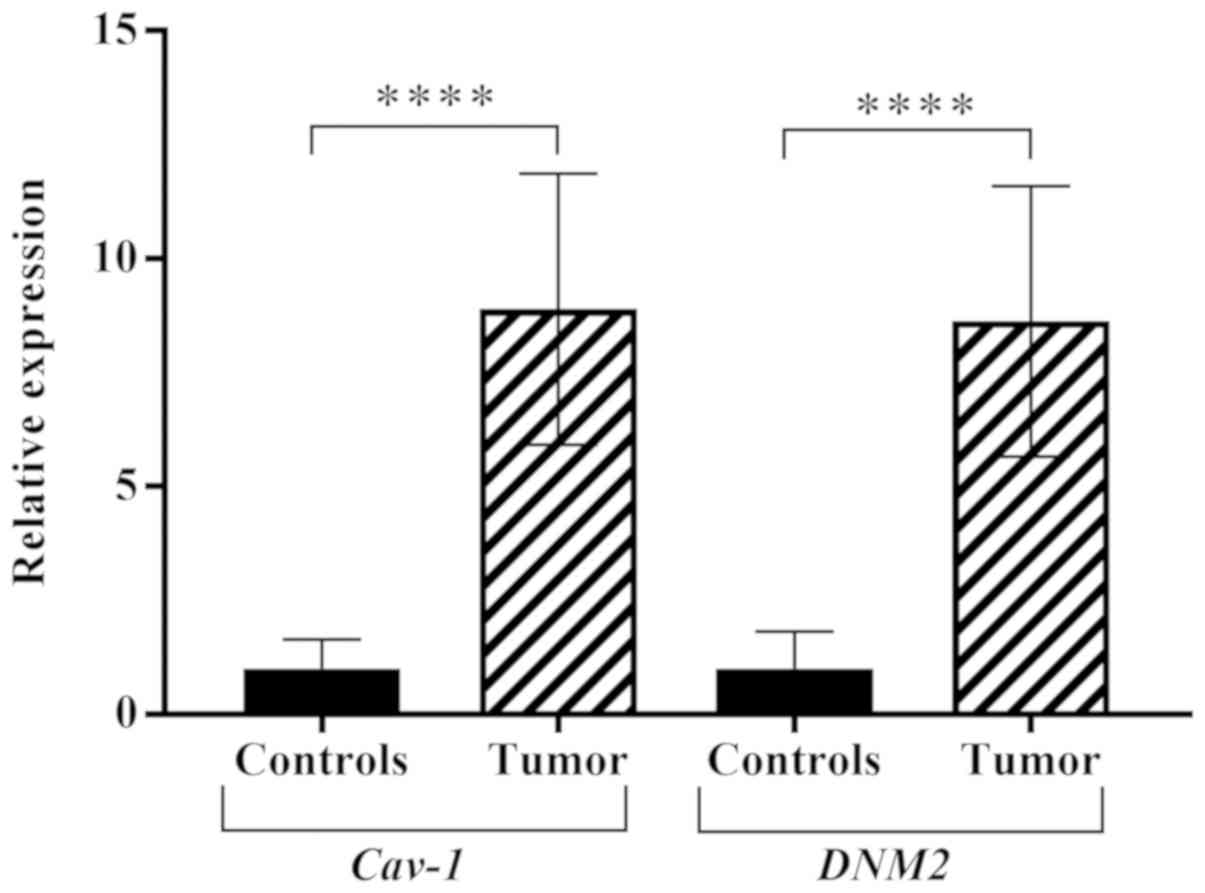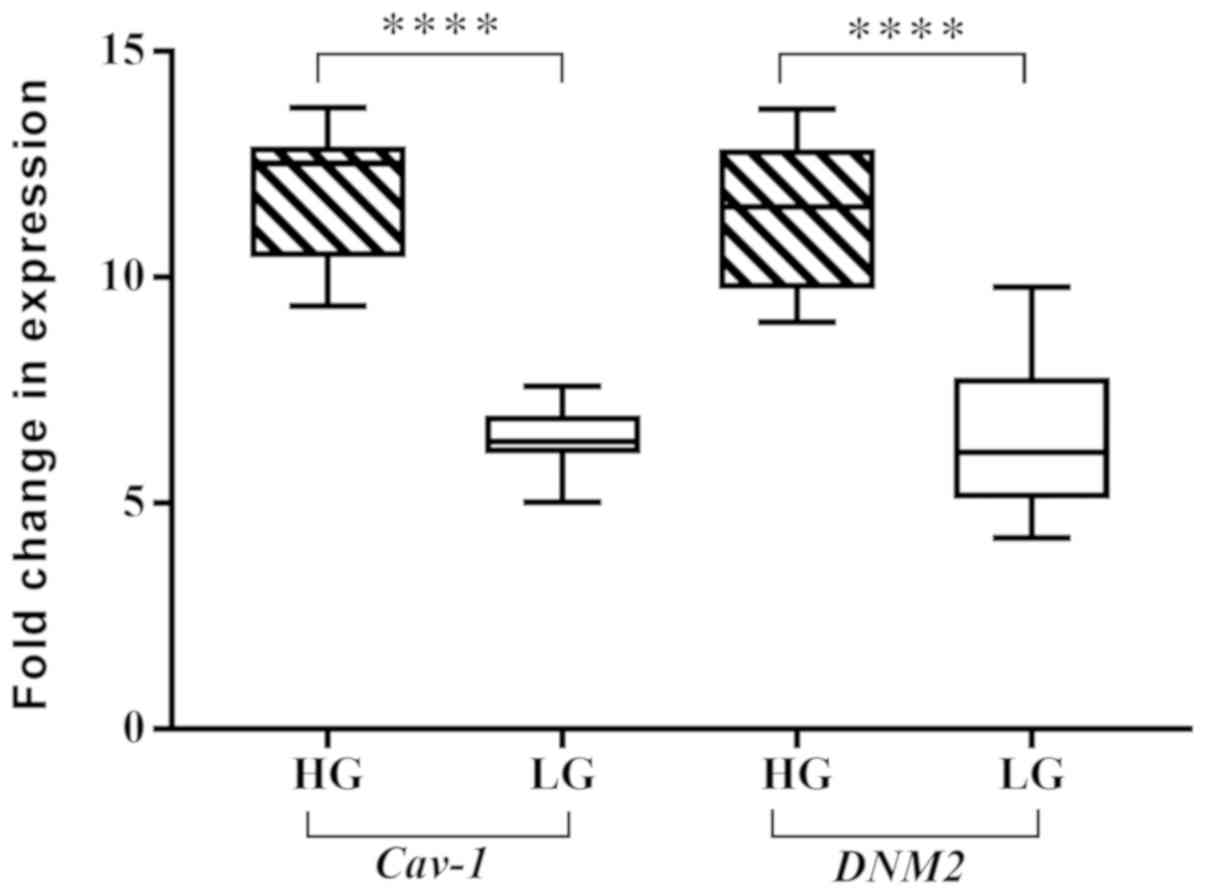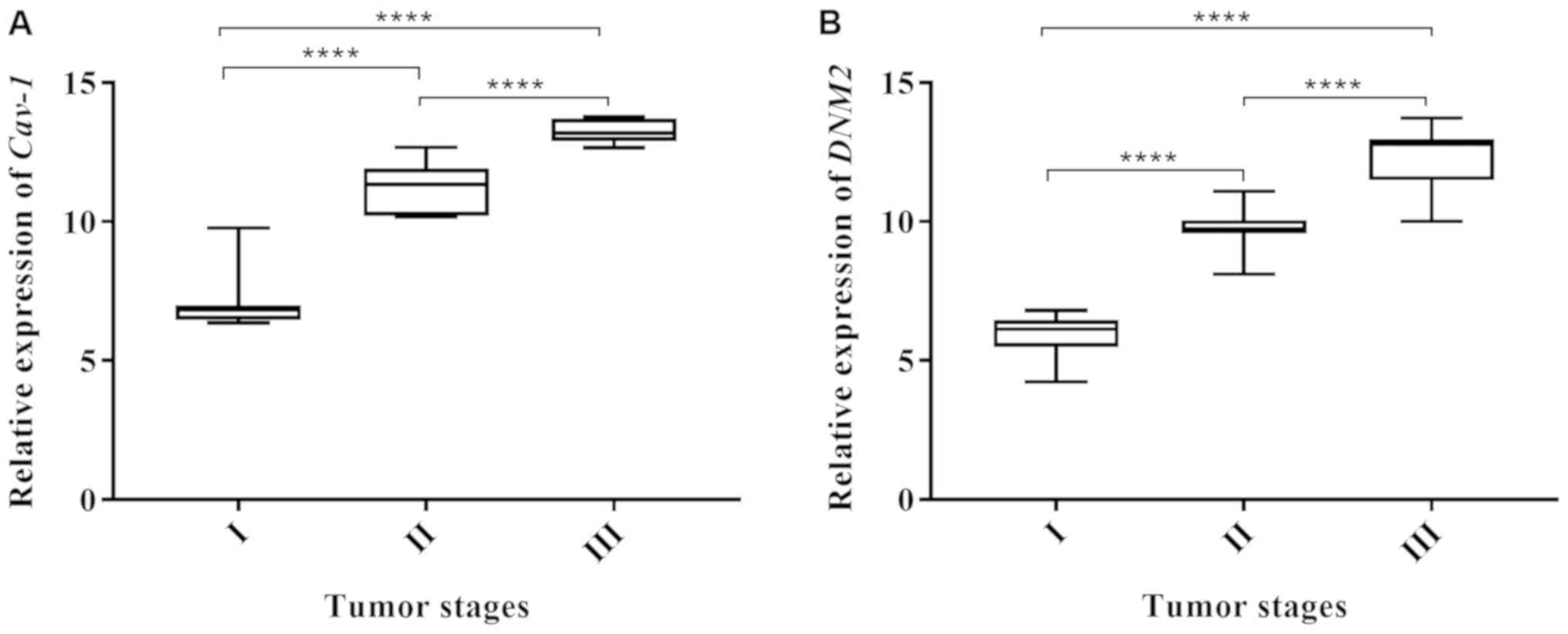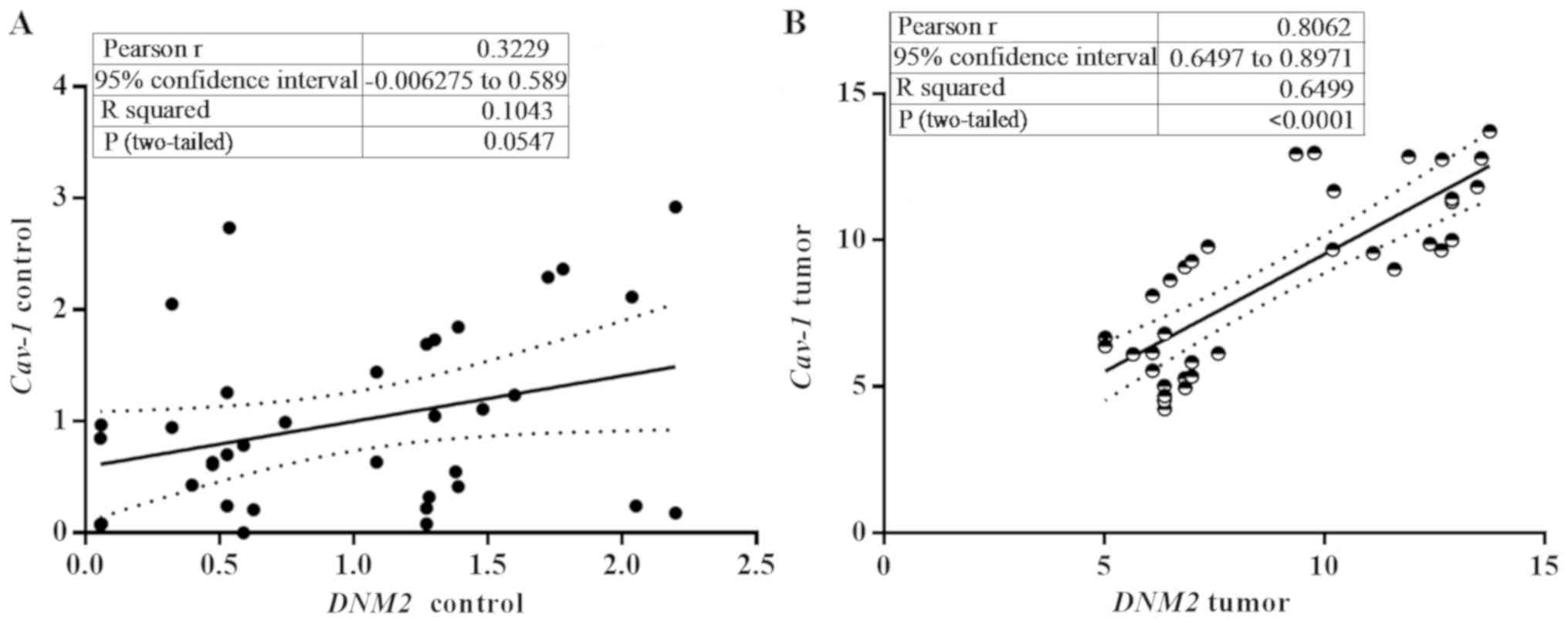|
1
|
Bastiani M and Parton RG: Caveolae at a
glance. J Cell Sci. 123:3831–3836. 2010. View Article : Google Scholar : PubMed/NCBI
|
|
2
|
Anderson RG: The Caveolae membrane system.
Annu Rev Biochem. 67:199–225. 1998. View Article : Google Scholar : PubMed/NCBI
|
|
3
|
Yamada E: The fine structure of the gall
bladder epithelium of the mouse. J Biophys Biochem Cytol.
1:445–458. 1955. View Article : Google Scholar : PubMed/NCBI
|
|
4
|
Cheng JPX and Nichols BJ: Caveolae: One
function or many? Trends Cell Biol. 26:177–189. 2016. View Article : Google Scholar : PubMed/NCBI
|
|
5
|
Martinez-Outschoorn UE, Sotgia F and
Lisanti MP: Caveolae and signalling in cancer. Nat Rev Cancer.
15:225–237. 2015. View
Article : Google Scholar : PubMed/NCBI
|
|
6
|
Parton RG and Pozo MA: Caveolae as plasma
membrane sensors, protectors and organizers. Nat Rev Mol Cell Biol.
14:98–112. 2013. View
Article : Google Scholar : PubMed/NCBI
|
|
7
|
Ludwig A, Howard G, Mendoza-Topaz C,
Deerinck T, Mackey M, Sandin S, Ellisman MH and Nichols BJ:
Molecular composition and ultrastructure of the caveolar coat
complex. PLoS Biol. 11:e10016402013. View Article : Google Scholar : PubMed/NCBI
|
|
8
|
Patel HH, Murray F and Insel PA: Caveolae
as organizers of pharmacologically relevant signal transduction
molecules. Annu Rev Pharmacol Toxicol. 48:359–391. 2008. View Article : Google Scholar : PubMed/NCBI
|
|
9
|
Yao Q, Chen J, Cao H, Orth JD, McCaffery
JM, Stan RV and McNiven MA: Caveolin-1 interacts directly with
dynamin-2. J Mol Biol. 348:491–501. 2005. View Article : Google Scholar : PubMed/NCBI
|
|
10
|
Mayor S, Parton RG and Donaldson JG:
Clathrin-independent pathways of endocytosis. Cold Spring Harb
Perspect Biol. 6:a0167582014. View Article : Google Scholar : PubMed/NCBI
|
|
11
|
Liu P, Rudick M and Anderson RG: Multiple
functions of caveolin-1. J Biol Chem. 277:41295–41298. 2002.
View Article : Google Scholar : PubMed/NCBI
|
|
12
|
Urra H, Torres VA, Ortiz RJ, Lobos L, Díaz
MI, Díaz N, Härtel S, Leyton L and Quest A: Caveolin-1-enhanced
motility and focal adhesion turnover require tyrosine-14 but not
accumulation to the rear in metastatic cancer cells. PLoS One.
7:e330852012. View Article : Google Scholar : PubMed/NCBI
|
|
13
|
Chatterjee M, Ben-Josef E, Thomas DG,
Morgan MA, Zalupski MM, Khan G, Andrew Robinson C, Griffith KA,
Chen CS, Ludwig T, et al: Caveolin-1 is associated with tumor
progression and confers a multi-modality resistance phenotype in
pancreatic cancer. Sci Rep. 5:108672015. View Article : Google Scholar : PubMed/NCBI
|
|
14
|
Hinshaw JE: Dynamin and its role in
membrane fission. Annu Rev Cell Dev Biol. 16:483–519. 2000.
View Article : Google Scholar : PubMed/NCBI
|
|
15
|
Normanno N, De Luca A, Bianco C, Strizzi
L, Mancino M, Maiello MR, Carotenuto A, De Feo G, Caponigro F and
Salomon DS: Epidermal growth factor receptor (EGFR) signaling in
cancer. Gene. 366:2–16. 2006. View Article : Google Scholar : PubMed/NCBI
|
|
16
|
Basu Roy UK, Rial NS, Kachel KL and Gerner
EW: Activated K-RAS increases polyamine uptake in human colon
cancer cells through modulation of caveolar endocytosis. Mol
Carcinog. 47:538–553. 2008. View Article : Google Scholar : PubMed/NCBI
|
|
17
|
Feng H, Liu KW, Guo P, Zhang P, Cheng T,
McNiven MA, Johnson GR, Hu B and Cheng SY: Dynamin 2 mediates
PDGFRalpha-SHP-2-promoted glioblastoma growth and invasion.
Oncogene. 31:2691–2702. 2012. View Article : Google Scholar : PubMed/NCBI
|
|
18
|
Eppinga RD, Krueger EW, Weller SG, Zhang
L, Cao H and McNiven MA: Increased expression of the large GTPase
dynamin 2 potentiates metastatic migration and invasion of
pancreatic ductal carcinoma. Oncogene. 31:1228–1241. 2012.
View Article : Google Scholar : PubMed/NCBI
|
|
19
|
Meng J: Distinct functions of dynamin
isoforms in tumorigenesis and their potential as therapeutic
targets in cancer. Oncotarget. 8:41701–41716. 2017. View Article : Google Scholar : PubMed/NCBI
|
|
20
|
Alshenawy HA and Ali MA: Differential
caveolin-1 expression in colon carcinoma and its relation to
E-cadherin-beta-catenin complex. Ann Diagn Pathol. 17:476–482.
2013. View Article : Google Scholar : PubMed/NCBI
|
|
21
|
Patlolla JM, Swamy MV, Raju J and Rao CV:
Overexpression of caveolin-1 in experimental colon adenocarcinomas
and human colon cancer cell lines. Oncol Rep. 11:957–963.
2004.PubMed/NCBI
|
|
22
|
Tanase CP: Caveolin-1: A marker for
pancreatic cancer diagnosis. Expert Rev Mol Diagn. 8:395–404. 2008.
View Article : Google Scholar : PubMed/NCBI
|
|
23
|
Sarwar MR and Saqib A: Cancer prevalence,
incidence and mortality rates in Pakistan in 2012. Cogent Med.
4:12887732017. View Article : Google Scholar
|
|
24
|
Robertson AG, Kim J, Al-Ahmadie H,
Bellmunt J, Guo G, Cherniack AD, Hinoue T, Laird PW, Hoadley KA,
Akbani R, et al: Comprehensive molecular characterization of
muscle-invasive bladder cancer. Cell. 171:540–556.e525. 2017.
View Article : Google Scholar : PubMed/NCBI
|
|
25
|
Zhang X and Zhang Y: Bladder cancer and
genetic mutations. Cell Biochem Biophys. 73:65–69. 2015. View Article : Google Scholar : PubMed/NCBI
|
|
26
|
Wang K, Liu T, Liu C, Meng Y, Yuan X, Liu
L, Ge N, Liu J, Wang C, Ren H, et al: TERT promoter mutations and
TERT mRNA but not FGFR3 mutations are urinary biomarkers in Han
Chinese patients with urothelial bladder cancer. Oncologist.
20:263–269. 2015. View Article : Google Scholar : PubMed/NCBI
|
|
27
|
Zhao M, He XL and Teng XD: Understanding
the molecular pathogenesis and prognostics of bladder cancer: An
overview. Chin J Cancer Res. 28:92–98. 2016.PubMed/NCBI
|
|
28
|
Rosenblatt R, Jonmarker S, Lewensohn R,
Egevad L, Sherif A, Kälkner KM, Nilsson S, Valdman A and Ullén A:
Current status of prognostic immunohistochemical markers for
urothelial bladder cancer. Tumour Biol. 29:311–322. 2008.
View Article : Google Scholar : PubMed/NCBI
|
|
29
|
Sever R and Brugge JS: Signal transduction
in cancer. Cold Spring Harb Perspect Med. 5:a0060982015. View Article : Google Scholar : PubMed/NCBI
|
|
30
|
Massey KA and Schnitzer JE: Caveolae and
cancer. Recent Results Cancer Res. 180:217–231. 2010. View Article : Google Scholar : PubMed/NCBI
|
|
31
|
Gupta R, Toufaily C and Annabi B: Caveolin
and cavin family members: Dual roles in cancer. Biochimie.
107:188–202. 2014. View Article : Google Scholar : PubMed/NCBI
|
|
32
|
Chen D and Che G: Value of caveolin-1 in
cancer progression and prognosis: Emphasis on cancer-associated
fibroblasts, human cancer cells and mechanism of caveolin-1
expression (review). Oncol Lett. 8:1409–1421. 2014. View Article : Google Scholar : PubMed/NCBI
|
|
33
|
Soria F, Lucca I, Moschini M, Mathieu R,
Rouprêt M, Karakiewicz PI, Briganti A, Rink M, Gust KM, Hassler MR,
et al: Caveolin-1 as prognostic factor of disease recurrence and
survival in patients treated with radical cystectomy for bladder
cancer. Urol Oncol. 35:356–362. 2017. View Article : Google Scholar : PubMed/NCBI
|
|
34
|
Sanchez-Carbayo M, Socci ND, Lozano J,
Saint F and Cordon-Cardo C: Defining molecular profiles of poor
outcome in patients with invasive bladder cancer using
oligonucleotide microarrays. J Clin Oncol. 24:778–789. 2006.
View Article : Google Scholar : PubMed/NCBI
|
|
35
|
Rosser CJ, Liu L, Sun Y, Villicana P,
McCullers M, Porvasnik S, Young PR, Parker AS and Goodison S:
Bladder cancer-associated gene expression signatures identified by
profiling of exfoliated urothelia. Cancer Epidemiol Biomarkers
Prev. 18:444–453. 2009. View Article : Google Scholar : PubMed/NCBI
|
|
36
|
Dyrskjot L, Zieger K, Kruhoffer M,
Thykjaer T, Jensen JL, Primdahl H, Aziz N, Marcussen N, Møller K
and Orntoft TF: A molecular signature in superficial bladder
carcinoma predicts clinical outcome. Clin Cancer Res. 11:4029–4036.
2005. View Article : Google Scholar : PubMed/NCBI
|
|
37
|
Gershenwald JE, Scolyer RA, Hess KR,
Sondak VK, Long GV, Ross MI, Lazar AJ, Faries MB, Kirkwood JM,
McArthur GA, et al: Melanoma staging: Evidence-based changes in the
American Joint Committee on cancer eighth edition cancer staging
manual. CA Cancer J Clin. 67:472–492. 2017. View Article : Google Scholar : PubMed/NCBI
|
|
38
|
Pan CC and Chang YH: The 2004 World Health
Organization/International Society of Urological Pathology
classification system for non-muscle-invasive bladder cancer. Urol
Sci. 24:96–100. 2013. View Article : Google Scholar
|
|
39
|
Zhang Y, Nolan M, Yamada H, Watanabe M,
Nasu Y, Takei K and Takeda T: Dynamin2 GTPase contributes to
invadopodia formation in invasive bladder cancer cells. Biochem
Biophys Res Commun. 480:409–414. 2016. View Article : Google Scholar : PubMed/NCBI
|
|
40
|
Ruan J and Weng ZL: Analysis of the
relationship between expression of caveolin-1 and prognosis in
bladder transitional cell carcinoma. Zhonghua Zhong Liu Za Zhi.
32:429–431. 2010.(In Chinese). PubMed/NCBI
|
|
41
|
Liang W, Hao Z, Han JL, Zhu DJ, Jin ZF and
Xie WL: CAV-1 contributes to bladder cancer progression by inducing
epithelial-to-mesenchymal transition. Urol Oncol. 32:855–863. 2014.
View Article : Google Scholar : PubMed/NCBI
|
|
42
|
Spiess PE, Agarwal N, Bangs R, Boorjian
SA, Buyyounouski MK, Clark PE, Downs TM, Efstathiou JA, Flaig TW,
Friedlander T, et al: Bladder cancer, version 5.2017, NCCN clinical
practice guidelines in oncology. J Natl Compr Canc Netw.
15:1240–1267. 2017. View Article : Google Scholar : PubMed/NCBI
|
|
43
|
Rio DC, Ares M Jr, Hannon GJ and Nilsen
TW: Purification of RNA using TRIzol (TRI reagent). Cold Spring
Harb Protoc. 2010.pdb.prot5439, 2010. View Article : Google Scholar
|
|
44
|
Livak KJ and Schmittgen TD: Analysis of
relative gene expression data using real-time quantitative PCR and
the 2(-Delta Delta C(T)) method. Methods. 25:402–408. 2001.
View Article : Google Scholar : PubMed/NCBI
|
|
45
|
Bangaru ML, Park F, Hudmon A, McCallum JB
and Hogan QH: Quantification of gene expression after painful nerve
injury: Validation of optimal reference genes. J Mol Neurosci.
46:497–504. 2012. View Article : Google Scholar : PubMed/NCBI
|
|
46
|
Cancer. Net Editorial Board: Bladder
Cancer-Risk Factors. https://www.cancer.net/cancer-types/bladder-cancer/risk-factorsJune
25–2012
|
|
47
|
Aghbolaghi AG and Lechpammer M: A rare
case of centronuclear myopathy with DNM2 mutation:
Genotype-phenotype correlation. Autops Case Rep. 7:43–48. 2017.
View Article : Google Scholar : PubMed/NCBI
|
|
48
|
Duregon E, Senetta R, Bertero L, Bussolati
B, Annaratone L, Pittaro A, Papotti M, Marchiò C and Cassoni P:
Caveolin 1 expression favors tumor growth and is associated with
poor survival in primary lung adenocarcinomas. Tumour Biol.
39:10104283176943112017. View Article : Google Scholar : PubMed/NCBI
|
|
49
|
Lee SW, Reimer CL, Oh P, Campbell DB and
Schnitzer JE: Tumor cell growth inhibition by caveolin
re-expression in human breast cancer cells. Oncogene. 16:1391–1397.
1998. View Article : Google Scholar : PubMed/NCBI
|
|
50
|
Lin M, DiVito MM, Merajver SD, Boyanapalli
M and van Golen KL: Regulation of pancreatic cancer cell migration
and invasion by RhoC GTPase and Caveolin-1. Mol Cancer. 4:212005.
View Article : Google Scholar : PubMed/NCBI
|
|
51
|
Friedl P and Alexander S: Cancer invasion
and the microenvironment: Plasticity and reciprocity. Cell.
147:992–1009. 2011. View Article : Google Scholar : PubMed/NCBI
|
|
52
|
Kang HW, Kim WJ and Yun SJ: The role of
the tumor microenvironment in bladder cancer development and
progression. Transl Cancer Res. 6 (Suppl):S744–S758. 2017.
View Article : Google Scholar
|
|
53
|
Sotgia F, Martinez-Outschoorn UE, Howell
A, Pestell RG, Pavlides S and Lisanti MP: Caveolin-1 and cancer
metabolism in the tumor microenvironment: Markers, models, and
mechanisms. Annu Rev Pathol. 7:423–467. 2012. View Article : Google Scholar : PubMed/NCBI
|
|
54
|
Wang M, Zhao J, Zhang L, Wei F, Lian Y, Wu
Y, Gong Z, Zhang S, Zhou J, Cao K, et al: Role of tumor
microenvironment in tumorigenesis. J Cancer. 8:761–773. 2017.
View Article : Google Scholar : PubMed/NCBI
|
|
55
|
Nwosu ZC, Ebert MP, Dooley S and Meyer C:
Caveolin-1 in the regulation of cell metabolism: A cancer
perspective. Mol Cancer. 15:712016. View Article : Google Scholar : PubMed/NCBI
|
|
56
|
Diaz-Valdivia N, Bravo D, Huerta H,
Henriquez S, Gabler F, Vega M, Romero C, Calderon C, Owen GI,
Leyton L and Quest AF: Enhanced caveolin-1 expression increases
migration, anchorage-independent growth and invasion of endometrial
adenocarcinoma cells. BMC Cancer. 15:4632015. View Article : Google Scholar : PubMed/NCBI
|
|
57
|
Girard E, Paul JL, Fournier N, Beaune P,
Johannes L, Lamaze C and Védie B: The Dynamin Chemical Inhibitor
Dynasore Impairs Cholesterol Trafficking and Sterol-Sensitive Genes
Transcription in Human HeLa Cells and Macrophages. PLoS One.
6:e290422011. View Article : Google Scholar : PubMed/NCBI
|
|
58
|
Lee YY, Jeon HK, Lee J, Do IG, Choi CH,
Kim TJ, Kim BG, Bae DS, Kim YC and Lee JW: Dynamin 2 inhibitors as
novel therapeutic agents against cervical cancer cells. Anticancer
Res. 36:6381–6388. 2016. View Article : Google Scholar : PubMed/NCBI
|
|
59
|
Galbiati F, Volonte D, Liu J, Capozza F,
Frank PG, Zhu L, Pestell RG and Lisanti MP: Caveolin-1 expression
negatively regulates cell cycle progression by inducing G(0)/G(1)
arrest via a p53/p21(WAF1/Cip1)-dependent mechanism. Mol Biol Cell.
12:2229–2244. 2001. View Article : Google Scholar : PubMed/NCBI
|
|
60
|
Nunez-Wehinger S, Ortiz RJ, Diaz N, Diaz
J, Lobos-Gonzalez L and Quest AF: Caveolin-1 in cell migration and
metastasis. Curr Mol Med. 14:255–274. 2014. View Article : Google Scholar : PubMed/NCBI
|
|
61
|
Sun DS, Hong SA, Won HS, Yoo SH, Lee HH,
Kim O and Ko YH: Prognostic value of metastatic tumoral caveolin-1
expression in patients with resected gastric cancer. Gastroenterol
Res Pract. 2017:59051732017. View Article : Google Scholar : PubMed/NCBI
|
|
62
|
Ge Z, Gu Y, Han Q, Zhao G, Li M, Li J,
Chen B, Sun T, Dovat S, Gale RP and Song C: Targeting HIGH
DYNAMIN-2 (DNM2) expression by restoring ikaros function in acute
lymphoblastic leukemia. Sci Rep. 6:380042016. View Article : Google Scholar : PubMed/NCBI
|
|
63
|
Quest AF, Gutierrez-Pajares JL and Torres
VA: Caveolin-1: An ambiguous partner in cell signalling and cancer.
J Cell Mol Med. 12:1130–1150. 2008. View Article : Google Scholar : PubMed/NCBI
|


















